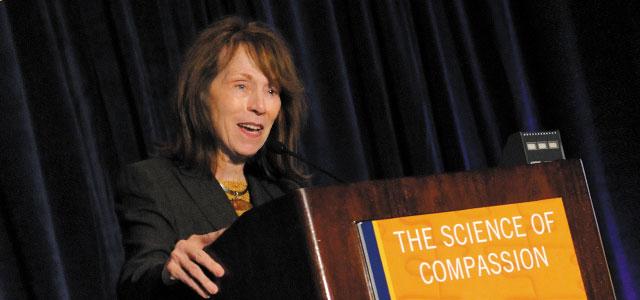
Patricia Grady, director of the National Institute of Nursing Research (NINR) at the National Institutes of Health
Leading the Charge for More and Better Palliative Care
An interview with Patricia Grady, director of the National Institute of Nursing Research (NINR) at the National Institutes of Health
Have you discerned a growing interest in palliative care?
Very definitely and I think the explanation for the interest is simple. Nearly everyone has dealt with or will deal with this issue. Quite frankly, just looking at the demographics, there are more and more people in this category of needing more care.
Why is it important to make the distinction between palliative care and end-of-life care?
Palliative care is symptom management toward improving health, state of comfort and quality of life.… It may lead to end-of-life care if things don’t improve, but it doesn’t have to. People do get better and go home. That’s why the vocabulary is morphing into terms such as life-limiting or life-threatening, because it is harder to have discussions about this type of care if people are only focused on end-of-life.
And that’s one area we are making progress in: fostering more open discussion. We’re now able to write about and discuss things that in the past people have been reluctant to discuss. And if things are not discussed, then progress may be limited. Despite the fact that much of the national attention has been couched in negative terms – the “death squads” – we’ve been able to show that people with things like advance directives…receive what is perceived as better care. There also is a positive long-term effect with the family members: less PTSD, decreased incidence of depression up to six months or so after the event.
Having the discussion is important because life happens. By reframing this, people are shifting from thinking about it as “the end” to thinking about it as something to help make every minute count. But we’re still working on it, with public information campaigns, educational programs, having investigators engage in the community and getting them as much coverage for their studies as possible.
How would you characterize the current state of palliative care research?
We have made significant progress in both pain and symptom management. We are learning more about the genetics of pain and biological variability, where people like Chris Miaskowski are doing great work. The increased interest in this stimulates drug development that can provide pain relief with decreased side effects. But we’re also making progress with nonpharmacological approaches that may decrease the number of drugs needed – things like positioning and exercise – and by virtue of decreased medication, we can decrease side effects.
How have you managed to make the research in this field such an interdisciplinary effort?
By engaging partners when we develop requests for funding applications and by bringing in experts from a variety of disciplines and from across the country. When we held our summit last year, with nearly a thousand people, it was very interdisciplinary, including the membership in the audience from societies, church groups and members of the public. The level of enthusiasm was remarkable.
Certainly, as the demand for palliative care grows, practicing nurses, nurse leaders and nurse researchers are needed; this is an area of science germane to our nursing profession, but it does not mean only nurses are doing it. So we try to stay focused on the science.… We want the care to be evidence-based and we want to do the science that underpins that, which means it has to be interdisciplinary.
Beyond funding the science, what else can the NINR do to advance the field?
Our role is to have information about resources available and to help people in the field anticipate change, communicate and address difficult issues.
One of the things we have identified is a need for training and education, which means we need to be active about promoting palliative care as a critical part of health care. We need people with expertise. Studies we’ve done identify needs and point to where we need to go next. This builds – and as palliative care becomes a priority, it creates a forum for discussion.
How do you think schools of nursing like UCSF contribute – or can do more to contribute – to the NINR’s mission around palliative care?
UCSF is a wonderful school, and the School of Nursing is particularly attuned to symptom management. It was one of the early schools with this focus, and they continue to recruit really good researchers, in pain in particular, as well as caregivers for conditions like heart failure. With their focus on symptom management, chronic illness and aging – and their outstanding faculty – UCSF is well situated to be a major driver in this area.



